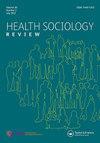Unequal neurorehabilitation trajectories – a longitudinal case study combining field structures with social Class–Based Capital Conversion
IF 2.5
2区 医学
Q2 HEALTH POLICY & SERVICES
引用次数: 2
Abstract
ABSTRACT Inequalities in illness, service provision, and outcomes are well documented in the Nordic universal welfare state. The ways in which inequalities are produced during illness recovery trajectories remain largely unknown. Long-term brain injury rehabilitation in this context provides a window into veiled aspects of inequality and the underlying mechanisms. We examine inequality empirically by combing framing field structures with the classed abilities of families to mobilise capital after a severe acquired brain injury (severe ABI). Using a Bourdieuan theoretical framework, informed by the concepts of field, doxa, cultural health capital (CHC), and rehabilitation capital (RC), we designed a longitudinal case study encompassing professional records, observations, and interviews that tracked and analysed subjects' trajectories. We found that families’ consistent accumulation and conversion of capital was crucial after a severe ABI because of the multifaceted rehabilitation process involving many different field specific agendas and doxas. This study supplements previous concepts (CHC and RC) developed in a health care context by including other rehabilitation contexts. These disparities in forms of capital amongst social classes result in winners and losers and were reflected in the rehabilitation trajectories of the young adults, characterised by continuity on one extreme and broken trajectories on the other.不平等的神经康复轨迹——结合领域结构与社会阶级资本转换的纵向案例研究
北欧普遍福利国家在疾病、服务提供和结果方面的不平等都有很好的记录。在疾病康复过程中产生不平等的方式在很大程度上仍然未知。在这种情况下,长期脑损伤康复为不平等和潜在机制的隐藏方面提供了一个窗口。我们通过将框架场结构与家庭在严重获得性脑损伤(严重ABI)后动员资本的分类能力相结合,实证地检查了不平等。利用布迪安理论框架,结合场域、doxa、文化健康资本(CHC)和康复资本(RC)的概念,我们设计了一个纵向案例研究,包括专业记录、观察和访谈,跟踪和分析了受试者的轨迹。我们发现,在严重的ABI之后,家庭持续的资本积累和转换是至关重要的,因为多方面的康复过程涉及许多不同的领域特定议程和doxas。本研究通过纳入其他康复背景,补充了先前在卫生保健背景下发展的概念(CHC和RC)。这些社会阶层之间资本形式的差异导致了赢家和输家,并反映在年轻人的康复轨迹中,其特征是一个极端的连续性和另一个极端的断裂轨迹。
本文章由计算机程序翻译,如有差异,请以英文原文为准。
求助全文
约1分钟内获得全文
求助全文
来源期刊

Health Sociology Review
Multiple-
CiteScore
7.50
自引率
0.00%
发文量
14
期刊介绍:
An international, scholarly peer-reviewed journal, Health Sociology Review explores the contribution of sociology and sociological research methods to understanding health and illness; to health policy, promotion and practice; and to equity, social justice, social policy and social work. Health Sociology Review is published in association with The Australian Sociological Association (TASA) under the editorship of Eileen Willis. Health Sociology Review publishes original theoretical and research articles, literature reviews, special issues, symposia, commentaries and book reviews.
 求助内容:
求助内容: 应助结果提醒方式:
应助结果提醒方式:


